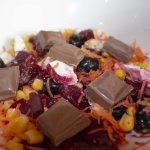When children are infants their feeds revolve around one thing: Milk. As they get older and their diet broadens, the nutritional advice gets more complicated.

The advice given about milk, once the bedrock of your child’s diet, becomes less prominent. It can be difficult to keep track of the latest nutritional advice and I had one or two, ahem, ‘passionate’ discussions with Mrs Adams on this very issue. We both had different opinions as to the approach we should take to giving our daughters, Helen and Izzy, milk once they hit the pre-school years.
Here are five things you need to know about pre-schoolers and milk. These tips come from a tip-sheet produced for the leader in light protection technology for packaging, Noluma, by food specialists Dr Catherine Birch and Prof Graham Bonwick from Newcastle University.
- The first point to mention is that milk provides essential nutrients the body can’t make itself. These are essential for disease prevention, good health and, particularly important for this age group, growth.
- It is recommended children over 12 months drink 240-360 millilitres of milk a day. This rises to 500 millilitres a day at two years of age.
- Consuming milk and dairy products will help a youngster meet their daily requirement for protein and calcium. These will help maintain strong teeth and bones.
- Children grow rapidly in their first five years of life. Inadequate intake of protein and calcium can lead to disorders such as anaemia, poor muscle development and weakened bones.
- Finally, for the benefit of your entire family, not just your children, you want milk that comes in certified packaging, which protects your milk from light damage. Scientific testing has shown that some nutrients, in particular protein and vitamin B2 (riboflavin), can decrease by 28% after just 20 minutes of light exposure. This light exposure can have detrimental effects on taste, producing off flavours and odours, decreased freshness, shortened shelf-life, reduced vitamins and impaired nutritional value overall. The only way to avoid that is buying milk in certified packaging which sufficiently blocks light.
I have to confess, that last point came as a particular surprise to me.
It has never occurred to me that the bottle the milk is in can leave it particularly susceptible to being damaged by light. Indoor lights such as LED lights and fluorescent lights can all have an impact.
If you want to find out more, or let your favourite retailer or milk brand know you want them to light protect their products, visit LightDamageIsReal.com.
Noluma’s tips have certainly got me thinking about how light can affect the nutritional value of milk. Is this something you would think of? Is it an issue you’ve ever considered? If so, I’d encourage you to comment below.
Disclosure: This commissioned article was produced in association with Noluma.







2 thoughts on “Five things you need to know about pre-schoolers and milk #ad”
And, John, I would add that I think it’s very important to use organic milk and dairy products. No hormones, no GMOs, etc. Especially for children.
Hi Jean – that’s a very good point. If you possibly can, I think it is best to ‘go organic.’ There’s a lot to consider regarding animal welfare in addition to nutrition, although the tip sheet focuses on the nutrition aspect.